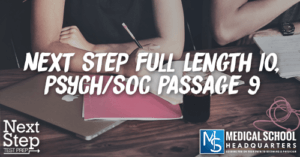You still have time to sign up with one of our amazing expert advisors! Learn More!

This week, we continue our breakdown of Blueprint MCAT (formerly Next Step Test Prep)’s full-length 10 with Passage #9 from Psych/Soc. We’re joined once again by Clara from Blueprint MCAT (formerly Next Step Test Prep).
Please visit Meded Media for many other podcasts for premeds and medical students.
Becoming a skilled musician requires considerable practice and this kind of learning relies on multiple faculties (e.g. perception, memory, and motor abilities). According to previous fMRI studies, the functional changes associated with musical training take the form of stronger activation in the temporal cortex (particularly the middle temporal gyrus) and somatosensory areas.
A study was performed to explore the impact of musical expertise on both functional and structural modifications of the brain. For this purpose, researchers selected 20 young musicians who had been playing music without interruption until the time of the study (number of years of practice: 15.3 +/- 3.67) and 20 young non-musicians. Participants were scanned using fMRI during a musical semantic memory task in which they had to rate the familiarity of 60 melodies (purely instrumental tonal excerpts) on a 4-point scale (from “non-familiar” = 1 to “extremely familiar” = 4).
Significant differences (p<0.001) were found in the number of melodies reported as unfamiliar between non-musicians and musicians. As expected, non-musicians judged more melodies to be totally unfamiliar and musicians judged more excerpts to be extremely familiar. In both musicians and non-musicians, familiarity increased activity in an extended network including left motor areas, the right cerebellum, and the left inferior parietal gyrus. Musicians showed greater activity in the bilateral anterior portion of the hippocampus and the bilateral superior temporal areas. Further analyses confirmed that the hippocampus is more strongly involved in musical familiarity judgment tasks in musicians than it is in non-musicians, regardless of gray matter density differences between the two groups.
Following the scanning session, a debriefing session was proposed to determine whether the melodies had evoked personal memories or mental imagery. This debriefing revealed that the musical excerpts evoked personal memories in 85% of musicians but in only 30% of non-musicians.
Personal memories evoked by musical excerpts would fall under which of the following categories?
Clara’s insights:
The correct answer here is B. Memory is highly tested on the MCAT so it’s important to know these terms.
In particular, episodic memory is the memory of events that happen to you during your life. Semantic memory would relate to facts like if the sky is blue or that 2×9=18.
Which of the following additional findings would NOT be supported by the data presented in the passage?
Clara’s insights:
The correct answer here is C. You might get tripped up with answer choice A thinking musicians and non-musicians are both going to store music-related memories in their long-term memory.
But the key is paragraph 3. It specifically says, “Musicians showed greater activity in the bilateral anterior portion of the hippocampus and the bilateral superior temporal areas.”
Then it further says, “that the hippocampus is more strongly involved in musical familiarity judgment tasks in musicians than it is in non-musicians.”
The hippocampus is the site associated with long-term memory.
These answer choices are totally independent of each other. So you have to evaluate each of them separately. This is a great place to prove which answer choices are wrong. For instance, C is not supported because it draws this distinction that it doesn’t exist.
And looking at answer choice D, procedural memories are memories of how to do different things like playing the piano. And this could be linked to episodic memories.
If a musician experienced a lesion in the cerebellum, which of the following functions would be most affected?
Clara’s insights:
The correct answer here is D. If you know what the different areas of the brain do then answering this would be super easy.
Cerebellum = movement.
Know the different areas of the brain and what they do.
The fMRI activation patterns obtained from the non-musicians functioned as:
Clara’s insights:
The correct answer here is D. B and C are opposite of each other so if it’s not one thing, then it has to be the other. But the reason D is the answer is because the patterns are both a control variable and a dependent variable.
We’re measuring the fMRI patterns and the dependent variable is what we’re essentially measuring. We’re measuring the changes in response to changes in an independent variable.
Check out Blueprint MCAT (formerly Next Step Test Prep) and look at their different packages of full-length exams. Buy 4, 6 or 10 of them and use the promo code MCATPOD to save some money.
Blueprint MCAT (formerly Next Step Test Prep) (promo code MCATPOD)

Lorem ipsum dolor sit amet, consectetur adipiscing elit
I just received my admission to XXXXX! This is unreal and almost feels like I am dreaming. I want to thank you for all of your help with my application. I cannot overstate how influential your guidance and insight have been with this result and I am eternally grateful for your support!
IM SO HAPPY!!!! THANK YOU SO MUCH FOR ALL YOUR HELP, IM INDEBTED TO YOU! Truly, thank you so much for all your help. Thank you doesnt do enough.
I want to take a few moments and thank you for all of your very instructive, kind and consistent feedback and support through my applications and it is your wishes, feedback, and most importantly your blessings that have landed me the acceptance!
I got into XXXXX this morning!!!! It still has not hit me that I will be a doctor now!! Thank you for all your help, your words and motivation have brought me to this point.
I wanted to once again express my heartfelt gratitude for your help in providing feedback during my secondary applications. Your guidance has been instrumental in my journey.
Just wanted to share my wonderful news! I received my first medical school acceptance! Thank you for all that you do for us Application Academy!!!
I am excited to tell you that I just got my third interview invite from XXXXX today! I can’t believe it. I didn’t even know if I was good enough to get one, let alone three – by mid-September. Thank you so much for all of your help and support up to this point; I would not be in this position without it!!
I wanted to thank you for helping me prepare for my XXXXX interview. Even in a 30-minute advising session, I learned so much from you. Thank you for believing in me, and here’s to another potential success story from one of your advisees!
I just received an acceptance with XXXXX! This is so exciting and such a huge relief and so nice to have one of our top choice schools! I also received an interview with XXXXX which brings the total up to 20 interviews! Thank so much, none of this would have been possible without you!

Join our newsletter to stay up to date
* By subscribing you agree to with our Privacy Policy and provide consent to receive updates from our company.
Resources
Advising Services
Podcasts & Youtube
Books
About
Deal Lasts for

"*" indicates required fields